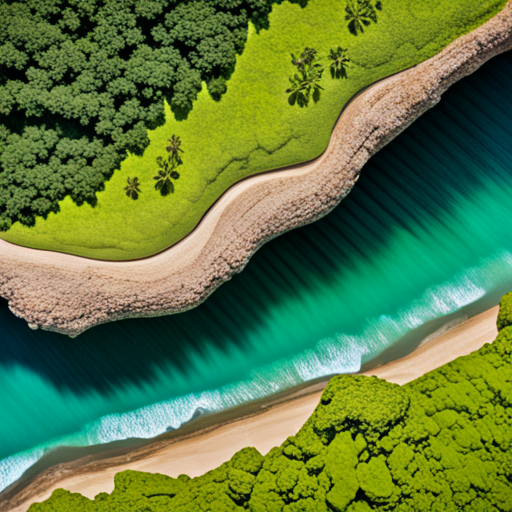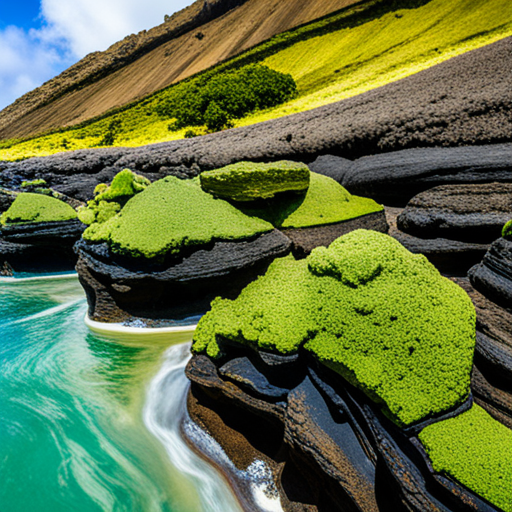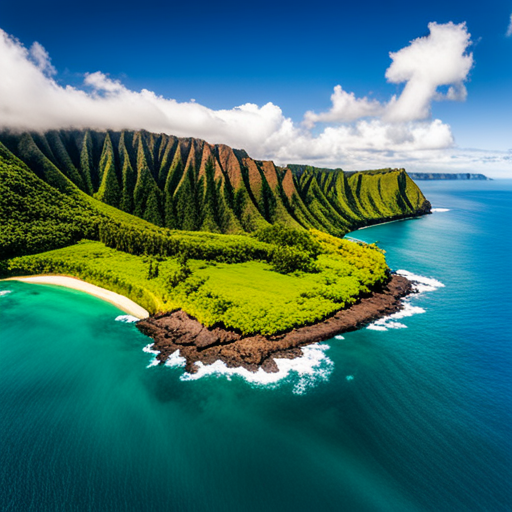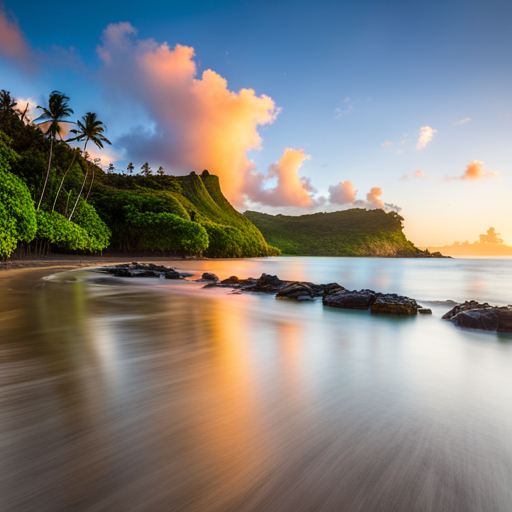Key Takeaways
- Green sand beaches in Hawaii are a unique natural wonder that showcase the beauty and diversity of the planet’s landscapes.
- The green color of these beaches comes from the rare mineral olivine, which is rich in iron and magnesium.
- The formation of green sand beaches is a result of erosion processes and the accumulation of olivine particles carried by waves.
Have you ever stumbled upon a hidden gem that seems too incredible to be true? Well, prepare to be amazed because Hawaii’s Green Sand Beaches are just that – a unique natural wonder that will leave you in awe.
Coincidences in nature are a fascinating phenomenon, and the formation of these mesmerizing beaches is no exception. As you step onto the soft, vibrant green sand, you can’t help but wonder how it came to be. The answer lies in the geology of these beaches, which we will explore together.
But what truly sets these beaches apart is their striking green color, a result of a rare mineral called olivine. As you immerse yourself in the beauty of these beaches, don’t be surprised if you encounter some incredible wildlife and marine life as well.
And if you’re seeking freedom and adventure, fear not – there are plenty of other attractions and activities to indulge in near these breathtaking beaches. But as you embark on this journey, remember the importance of conservation and preservation, for it is our duty to protect these wonders for future generations.
Table of Contents
So, get ready to discover Hawaii’s Green Sand Beaches and let your spirit roam free in this extraordinary natural paradise.
– The presence of green sand beaches in Hawaii is tied to volcanic activity, as lava flows carry olivine-rich minerals to the shoreline.
The Formation of Green Sand Beaches

So, you want to know how these incredible green sand beaches are formed, huh? Well, let me tell you, it’s quite a fascinating process.
These stunning beaches get their unique color from a combination of erosion processes and mineral composition.
You see, erosion plays a significant role in the formation of green sand beaches. Over time, waves crashing against the coastline gradually break down the rocks and cliffs, creating a mixture of fine particles. These particles consist of olivine, a green mineral that’s abundant in volcanic rocks found in Hawaii. As the waves continue to pound the shoreline, they carry these olivine particles and deposit them on the beach.
The mineral composition of the green sand beaches is what truly sets them apart. Olivine, also known as peridot, is formed deep within the Earth’s mantle and is rich in iron and magnesium. Its vibrant green color is a result of these elements. As the olivine particles accumulate on the beach, they mix with the existing sand, creating the distinctive green hue that’s so captivating.
So, the next time you set foot on a green sand beach in Hawaii, remember that its formation is a product of the powerful forces of erosion and the unique mineral composition of olivine. It’s a natural wonder that showcases the beauty and diversity of our planet’s landscapes.
Exploring the Geology of Green Sand Beaches

With the help of erosion and natural processes, these emerald shores are formed, showcasing the mesmerizing results of time and nature’s handiwork. Green sand beaches are a true wonder to behold, and understanding their geology adds to the appreciation of their beauty. Here’s what you need to know:
- Understanding Erosion:
– Erosion, the gradual wearing away of rock and soil, plays a significant role in the formation of green sand beaches.
– The relentless power of ocean waves crashing against the coastline gradually breaks down volcanic rocks, creating small particles of green olivine.
– Over time, these olivine particles accumulate, creating the distinctive green color of the sand.
- Volcanic Activity:
– The presence of green sand beaches is closely tied to volcanic activity.
– Hawaii’s Big Island, particularly the southernmost point, is home to numerous volcanic eruptions that have contributed to the formation of these beaches.
– Lava flows from nearby volcanoes, such as Mauna Loa and Kilauea, carry olivine-rich minerals to the shoreline, where they’re eventually transformed into green sand.
Exploring the geology of green sand beaches offers an incredible opportunity to witness the forces of nature at work. As you stand on these unique shores, you can marvel at the intricate dance between volcanic activity, erosion, and time that has created this natural wonder. So, go ahead, set foot on the emerald sands, and let the freedom of nature’s artistry captivate your senses.
The Unique Green Color of the Sand
But have you ever wondered about the composition of this green sand and the origins of its vibrant color?
The green sand found on these beaches is composed of a mineral called olivine. Olivine is a magnesium iron silicate that is commonly found in volcanic rocks. When lava erupts from the volcano and cools rapidly, the olivine crystals are formed. Over time, these crystals are weathered and eroded by the ocean waves, creating the green sand that we see today.
But what gives the olivine its green color? The green color is actually due to the presence of iron in the mineral. The iron in the olivine oxidizes and forms a green pigment called ferric iron. This pigment gives the sand its distinct green color, ranging from light green to dark green depending on the concentration of iron.
So, as you stroll along the green sand beaches of Hawaii, take a moment to appreciate the unique composition and origins of the green sand color. It’s a natural wonder that adds to the allure and beauty of these incredible coastal landscapes.
Wildlife and Marine Life at Green Sand Beaches
Get ready to encounter endangered species and their unique habitats as you immerse yourself in the natural wonders of these beaches.
Don’t forget to bring your snorkeling and diving gear, as the crystal-clear waters offer unparalleled opportunities to witness the vibrant underwater world up close.
So, grab your gear and prepare for an adventure like no other at the green sand beaches of Hawaii.
Endangered Species and Habitats
Explore Hawaii’s green sand beaches and marvel at the incredible array of endangered species and habitats. You’ll encounter a mind-blowing variety of life forms that will leave you feeling like you’ve stepped into an exotic paradise.
These pristine beaches are not only a visual feast, but they also serve as crucial breeding grounds and sanctuaries for endangered species. The conservation efforts in this area are focused on protecting natural habitats and ensuring the survival of these unique creatures.
From the endangered Hawaiian monk seals basking in the sun to the rare green sea turtles gracefully gliding through the turquoise waters, every moment spent on these beaches offers a chance to witness the wonders of nature up close.
By respecting these fragile ecosystems and supporting the conservation initiatives, you can help safeguard the future of these endangered species and their habitats for generations to come.
Snorkeling and Diving Opportunities
Immerse yourself in the breathtaking underwater world of Hawaii’s snorkeling and diving opportunities, where you’ll be surrounded by vibrant coral reefs and encounter an enchanting array of marine life.
As you explore the crystal-clear waters, get ready to capture stunning moments with underwater photography. Hawaii’s marine biodiversity is a treasure trove waiting to be discovered.
From colorful schools of fish darting through the coral to graceful sea turtles gliding by, every dive is a chance to witness nature’s beauty up close. The sheer variety of species you’ll encounter is astounding, from the elusive octopus hiding in crevices to the majestic manta rays gracefully swimming by.
So grab your snorkel or scuba gear, and prepare for an adventure that will leave you in awe of Hawaii’s underwater wonders.
Tips for Visiting Green Sand Beaches

Prepare for an unforgettable adventure at Hawaii’s green sand beaches, where you’ll find tips to make your visit truly epic.
When planning your trip, it’s essential to consider the best time to visit these unique natural wonders. The ideal time is during the summer months, from May to September, when the weather is warm and dry, providing the perfect conditions for exploration and relaxation.
Now, let’s talk about transportation options. To reach the green sand beaches, you have two choices: hiking or hiring a local guide with a four-wheel-drive vehicle. If you’re up for a little adventure, the hike is approximately three miles each way, offering magnificent views of the coastline along the way. However, be prepared for the challenging terrain and bring plenty of water and sunscreen.
If hiking isn’t your thing, hiring a guide is a convenient option. They’ll take care of the transportation, ensuring a hassle-free journey to the beaches.
Once you arrive, take a moment to soak in the stunning beauty of the green sand. The unique color is caused by the presence of olivine, a mineral found in the surrounding volcanic rocks. You can even take a piece of this rare gem as a souvenir, but remember to only collect small amounts and leave the majority for others to enjoy.
Visiting Hawaii’s green sand beaches is an adventure you won’t want to miss. Plan your trip during the best time and choose the transportation option that suits your preference. Get ready to immerse yourself in the freedom of nature and create memories that’ll last a lifetime.
Other Attractions and Activities Near Green Sand Beaches

Now that you have explored the tips for visiting Green Sand Beaches, let’s dive into the other attractions and activities that await you near these unique natural wonders. Hawaii is not only known for its breathtaking beaches, but also for its stunning hiking trails that offer panoramic views of the island’s lush landscapes. Whether you are an experienced hiker or a casual nature enthusiast, there is a trail for everyone to enjoy near the Green Sand Beaches.
To make your adventure even more enticing, the local cuisine in Hawaii is a true delight. After a long day of exploring, you can indulge in mouthwatering dishes that showcase the diverse flavors of the island. From fresh seafood caught just off the coast to exotic fruits grown in the fertile volcanic soil, every bite is a culinary delight.
To give you an idea of what awaits you, here’s a table showcasing some of the popular hiking trails and local cuisines near the Green Sand Beaches:
| Hiking Trails | Local Cuisine |
|---|---|
| Pololu Valley Trail | Poke Bowls |
| Waipio Valley Trail | Kalua Pork |
| Kilauea Iki Trail | Loco Moco |
| Diamond Head Trail | Shave Ice |
| Manoa Falls Trail | Plate Lunch |
So, after a day of exploring the stunning green sand beaches, lace up your hiking boots and treat yourself to the delicious flavors of Hawaii’s local cuisine. The possibilities for adventure and indulgence are endless!
The Importance of Conservation and Preservation

Preserving the beauty of these natural wonders is essential for future generations to experience and enjoy. When it comes to Hawaii’s green sand beaches, conservation initiatives play a crucial role in ensuring their long-term survival.
These unique beaches are not only a breathtaking sight but also a delicate ecosystem that requires protection. Conservation initiatives are focused on minimizing the environmental impact caused by human activities. The fragile ecosystem of green sand beaches can easily be disrupted by excessive tourism, pollution, and erosion. By implementing sustainable practices, such as limiting visitor numbers and educating tourists about responsible behavior, we can help preserve the natural beauty of these beaches.
One of the key aspects of conservation is raising awareness about the importance of these natural wonders. By educating visitors about the fragility of the ecosystem and the impact of their actions, we can encourage a sense of responsibility and respect for the environment. This can be done through informative signage, guided tours, and educational programs.
Furthermore, conservation efforts also involve habitat restoration and protection. By planting native vegetation, controlling invasive species, and implementing erosion control measures, we can help maintain the integrity of the beaches and prevent further degradation.
Preserving Hawaii’s green sand beaches is not only crucial for their own sake but also for the overall well-being of the planet. These unique natural wonders serve as a reminder of the beauty and diversity of our world. By supporting conservation initiatives and being mindful of our environmental impact, we can ensure that future generations will have the opportunity to experience and enjoy these remarkable treasures.
Frequently Asked Questions
How can I reach the green sand beaches in Hawaii?
To reach the incredible green sand beaches in Hawaii, hop on public transportation or follow the scenic hiking trails. Feel the freedom as you embark on a journey to witness this unique natural wonder. Remember, “No pain, no gain!”
Are there any safety concerns I should be aware of when visiting the green sand beaches?
When visiting the green sand beaches, it’s important to take safety precautions. Be aware of potential health risks like strong currents and sunburn. Stay hydrated, wear sunscreen, and swim only in designated areas.
Can I swim or snorkel in the waters surrounding the green sand beaches?
You can swim and snorkel in the waters surrounding the green sand beaches, but be aware of swimming regulations. The marine life around the beaches is diverse, offering an exciting and vibrant underwater experience.
Are there any facilities or amenities available at the green sand beaches?
You’ll be stoked to find out that there are some awesome facilities and amenities at the green sand beaches. From picnic areas to restrooms, you’ll have everything you need for a rad day of activities.
What is the best time of year to visit the green sand beaches in Hawaii?
The best time to visit the green sand beaches in Hawaii is during the dry season, from April to October. You’ll have the opportunity to explore the unique attractions that these beaches offer, such as the striking green sand and stunning coastal views.
Conclusion
So there you have it, fellow beach enthusiasts! The green sand beaches of Hawaii are truly a natural wonder like no other. You simply can’t miss the opportunity to witness the incredible formation of these beaches and explore their unique geology.
The vibrant green color of the sand will leave you in awe, and the diverse wildlife and marine life will captivate your senses. Remember to take note of the tips for visiting and make the most of your time near these magnificent beaches.
And let’s not forget the importance of conservation and preservation to ensure future generations can continue to enjoy this extraordinary beauty. Now, go and experience the magic of Hawaii’s green sand beaches for yourself, and prepare to be amazed!
